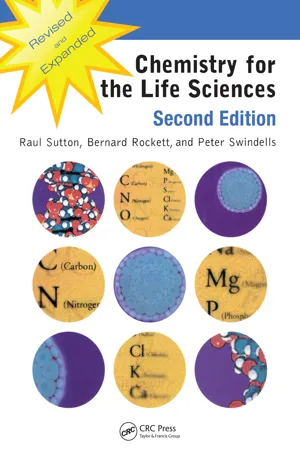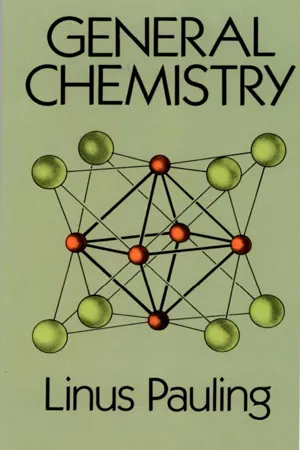Chemistry
Covalent Bond
A covalent bond is a type of chemical bond formed when two atoms share one or more pairs of electrons. This sharing of electrons allows both atoms to achieve a more stable electron configuration. Covalent bonds are typically found in molecules and are characterized by the strong attraction between the shared electrons and the positively charged nuclei of the bonded atoms.
Written by Perlego with AI-assistance
Related key terms
1 of 5
10 Key excerpts on "Covalent Bond"
- eBook - PDF
- Ageetha Vanamudan(Author)
- 2023(Publication Date)
- Delve Publishing(Publisher)
Source: By DynaBlast - Created with Inkscape, CC BY-SA 2.5, https://com- mons.wikimedia.org/w/index.php?curid=995735 Covalent Bonding 115 7.1 DO YOU UNDERSTAND WHY Covalent BondS FORM? When the difference in electronegativity between two atoms is insufficient for electron transit, a Covalent Bond is created. Electronegativity is a measure of an atom’s capacity to attract electrons. Atoms create Covalent Bonds to strengthen their stability by forming a whole electron shell by sharing their outermost (valence) electrons.The attraction between positively charged nuclei and shared electrons is stronger than the repulsion between them in Covalent Bonds. This attraction aids in the retention of the molecules. The amount of energy required to break the connection, or the amount of energy required to separate the connected atoms determines the strength of a Covalent Bond. Figure 7.2: Structure of the Covalent Bonding of methane. Source: By Original: Benjah-bmm27 Vector: Jynto - Own work based on: File:Methane-CRC-MW-dimensions-2D.png, Public Domain, https://com- mons.wikimedia.org/w/index.php?curid=12422898 7.2 Covalent Bond CHARACTERISTICS In the structure of stable covalent compounds, Covalent Bonding is typically the controlling factor. A Covalent Bond has the following characteristics and qualities: • It is possible to make multiple Covalent Bonds between two atoms when composed of two or more nonmetals, or one nonmetal and a metalloid. Breaking bonds requires a lot of energy, which is why it is so tough (Krylov & Gill, 2013). Directional or Isomerism is the phenomenon in which one chemical formula may represent several distinct molecules. Introduction to Molecular Science 116 • Covalent compounds have low melting and boiling temperatures, do not conduct electricity, and are insoluble in polar solvents such as water. Covalent substances can be dissolved using nonpolar solvents such as benzene and toluene. - eBook - PDF
- Raul Sutton(Author)
- 2008(Publication Date)
- CRC Press(Publisher)
15 Covalent Bonding and Molecules 2.1 Introduction A liing organism deries most of its character from the enormous range of molecules contained within it. These help to determine the structure of the body, the function of enzymes, the clotting of blood, cell respira-tion, and innumerable other features. It is useful for us to understand the structure of molecules and to consider the properties they show in order to interpret the role they perform in the organism. 2.2 Interactions between Atoms Proteins, sugars, and other important biological molecules are collec-tions of atoms held together by a force of attraction called Covalent Bonding . Coalent bonds are formed between atoms that can share electrons to achiee a full shell of electrons. Such a full shell is a ery stable structure. When two atoms moe toward one another, the outer-shell electrons in each rearrange themseles to reduce their poten-tial energy. The energy falls to a minimum when they are a specific distance apart. This distance, when measured between the two atomic nuclei, is called the bond length . The fall in energy that has occurred is the bond energy (Figure 2.1). Atoms share electrons to form Covalent Bonds. Atoms share electrons to form Covalent Bonds. 2 Potential Energy + – 0 r E Distance between Nuclei Figure 2.1 Potential energy change which occurs when two atoms are brought together to form a chemical bond. The fall in energy E corresponds to the energy of the chemical bond. The distance r between the nuclei of the two atoms represents the potential energy minimum and is the bond length. 16 Chemistry for Life Sciences 2.3 Covalent Bonds Are Formed by Sharing Outer Electrons The simplest way to describe the formation of a coalent bond is to consider the way in which the outer shells of electrons in the atoms interact as the atoms approach one another. The outer shell of electrons is often called the alence shell, so this description of coalent bond-ing is called the valence-bond theory . - eBook - ePub
- Linus Pauling(Author)
- 2014(Publication Date)
- Dover Publications(Publisher)
6The Chemical Bond
For over a century chemists have systematized the formulas of compounds by assigning certain combining powers, valences, to the elements. The valence of an element was formerly described as the number of valence bonds formed by an atom of the element with other atoms.The effort to obtain a clear understanding of the nature of valence and of chemical combination in general has led in recent years to the dissociation of the concept of valence into several new concepts—especially covalence and ionic valence. We shall discuss these concepts and the related question of the nature of the chemical bond in the present chapter.6-1. The Nature of Covalence
The atoms of most molecules are held tightly together by a very important sort of bond, the shared-electron-pair bond or Covalent Bond. This bond is so important, so nearly universally present in substances that Professor Gilbert Newton Lewis of the University of California (1875–1946), who discovered its electronic structure, called it the chemical bond.FIGURE 6-1The electron distribution function for the hydrogen molecule-ion. The upper curve shows the value of the function along the line through the two nuclei, and the lower figure shows contour lines, increasing from 0.1 for the outermost to 1 at the nuclei.It is the Covalent Bond that is represented by a dash in the valence-bond formulas, such as Br—Br and that have been written by chemists for over a hundred years. - eBook - PDF
- Paul Flowers, Klaus Theopold, Richard Langley, William R. Robinson(Authors)
- 2019(Publication Date)
- Openstax(Publisher)
For example, two hydrogen atoms bond covalently to form an H 2 molecule; each hydrogen atom in the H 2 molecule has two electrons stabilizing it, giving each atom the same number of valence electrons as the noble gas He. Compounds that contain Covalent Bonds exhibit different physical properties than ionic compounds. Because the attraction between molecules, which are electrically neutral, is weaker than that between electrically charged ions, covalent compounds generally have much lower melting and boiling points than ionic compounds. In fact, many covalent compounds are liquids or gases at room temperature, and, in their solid states, they are typically much softer than ionic solids. Furthermore, whereas ionic compounds are good conductors of electricity when dissolved in water, most covalent compounds are insoluble in water; since they are electrically neutral, they are poor conductors of electricity in any state. Formation of Covalent Bonds Nonmetal atoms frequently form Covalent Bonds with other nonmetal atoms. For example, the hydrogen molecule, H 2 , contains a Covalent Bond between its two hydrogen atoms. Figure 7.4 illustrates why this bond is formed. Starting on the far right, we have two separate hydrogen atoms with a particular potential energy, indicated by the red line. Along the x-axis is the distance between the two atoms. As the two atoms approach each other (moving left along the x-axis), their valence orbitals (1s) begin to overlap. The single electrons on each hydrogen atom then interact with both atomic nuclei, occupying the space around both atoms. The strong attraction of each shared electron to both nuclei stabilizes the system, and the potential energy decreases as the bond distance decreases. If the atoms continue to approach each other, the positive charges in the two nuclei begin to repel each other, and the potential energy increases. The bond length is determined by the distance at which the lowest potential energy is achieved. - eBook - PDF
- Brian W. Pfennig(Author)
- 2021(Publication Date)
- Wiley(Publisher)
4 An Introduction to Chemical Bonding “A bond does not really exist at all—it is a most convenient fiction.” —Charles Coulson 4.1 THE DEFINITION OF A CHEMICAL BOND Almost every chemical reaction involves the making and/or breaking of a chemical bond. Despite its central importance in the lexicon of chemistry, there continues to be a healthy debate about what a bond actually is, so much so that the British theoretician, Charles Coulson, once quipped that “a bond does not really exist at all—it is a most convenient fiction.” Suppose that I asked my students for their definition of a chemical bond. I imagine that many of them might turn to the fountain of all knowledge known as Wikipedia for a definition. Going straight to the source myself, Wikipedia defines a chemical bond as “a lasting attraction between atoms that enables the formation of a chemical compound,” a circular argument if ever there was one. The Collins English dic- tionary has only a slightly better answer, defining a bond as “a mutual attraction between two atoms resulting from a redistribution of their outer electrons.” Dissatisfied with either of these definitions, I thought I would turn to the OG himself—Gilbert Newton Lewis, who is arguably the godfather of the chemical bond. - eBook - PDF
Chemistry
An Atoms First Approach
- Steven Zumdahl, Susan Zumdahl, Donald J. DeCoste, , Steven Zumdahl, Steven Zumdahl, Susan Zumdahl, Donald J. DeCoste(Authors)
- 2020(Publication Date)
- Cengage Learning EMEA(Publisher)
During the twentieth century we learned that atoms have electrons and that these electrons participate in bonding one atom to another. ▲ Quartz grows in beautiful, regular crystals. 99 Copyright 2021 Cengage Learning. All Rights Reserved. May not be copied, scanned, or duplicated, in whole or in part. Due to electronic rights, some third party content may be suppressed from the eBook and/or eChapter(s). Editorial review has deemed that any suppressed content does not materially affect the overall learning experience. Cengage Learning reserves the right to remove additional content at any time if subsequent rights restrictions require it. The forces that hold atoms together in compounds are called chemical bonds. One way that atoms can form bonds is by sharing electrons. These bonds are called cova- lent bonds, and the resulting collection of atoms is called a molecule. Molecules can be represented in several different ways. The simplest method is the chemical formula, in which the symbols for the elements are used to indicate the types of atoms present and subscripts are used to indicate the relative numbers of atoms. For example, the formula for carbon dioxide is CO 2 , meaning that each molecule contains 1 atom of carbon and 2 atoms of oxygen. Examples of molecules that contain Covalent Bonds are hydrogen (H 2 ), water (H 2 O), oxygen (O 2 ), ammonia (NH 3 ), and methane (CH 4 ). More information about a molecule is given by its structural formula, in which the individual bonds are shown (indicated by lines). Structural formulas may or may not indicate the actual shape of the mole- cule. For example, water might be represented as H O H H H O or The structure on the right shows the actual shape of the water molecule. Scientists know from experimental evidence that the molecule looks like this. (We will study the shapes of molecules further in Chapter 4.) The structural formula for ammonia is Ammonia H H H N . - eBook - ePub
Understanding Basic Chemistry
The Learner's Approach
- Kim Seng Chan, Jeanne Tan(Authors)
- 2014(Publication Date)
- WSPC(Publisher)
For example, Al is a metal and Cl is a non-metal, but AlCl 3 is a covalent compound. Ultimately, what makes a reaction occur is determined by whether the energy change is favorable (see Chapter 5 on Energy Change and Fuels) and whether there is suffcient energy for the particles to react (see Chapter 6 on Rate of Chemical Reactions). 3.3.1 Formation of covalent compounds Covalent Bonds can be formed between two similar atoms of the same element or between two dissimilar atoms from different elements. Depending on the number of extra electrons each atom needs to fulfil the octet rule, there can be single bonds (e.g., H–H, Cl–Cl, H–Cl) or double bonds (e.g., O=O, O=C=O, C=C), or triple bonds (e.g., N≡N, H–C≡C–H), that can be formed between the two atoms. Each line “−” represents a pair of shared electrons. The particles formed are known as simple discrete molecules. For example: When a large number of atoms come together to form Covalent Bonds, we have a macromolecular compound or giant covalent compound. Examples are diamond, graphite, silicon dioxide (SiO 2), proteins, polymers, etc. 3.3.2 Dative Covalent Bonds/ coordinate bonds Usually, a single Covalent Bond consists of each bonding atom contributing one electron for bonding. It is also possible to have a single Covalent Bond being formed, whereby the pair of sharing electrons comes only from one atom, known as the donor atom. This type of bonding is known as dative Covalent Bonding or coordinate bonding. There is one donor atom with a lone pair of electrons to donate and a receiver (acceptor) atom which must not already have the octet configuration - eBook - PDF
- Morris Hein, Susan Arena, Cary Willard(Authors)
- 2016(Publication Date)
- Wiley(Publisher)
Between these extremes lie many cases in which the atoms are not different enough for a transfer of electrons but are different enough that the electron pair cannot be shared equally. This unequal sharing of electrons results in the formation of a polar Covalent Bond. 1s orbitals H H H H Overlapping 1s orbitals Hydrogen molecule Hydrogen atoms Shared pair of electrons . . . . FIGURE 11.8 The formation of a hydrogen molecule from two hydrogen atoms. The two 1s orbitals overlap, forming the H 2 molecule. In this molecule the two electrons are shared between the atoms, forming a Covalent Bond. p orbitals Overlap of p orbitals Paired p orbital Chlorine molecule Chlorine atoms Unshared p orbitals Shared pair of p electrons + Cl . . . . . . . . Cl . . . . . . Cl . . . . . . Cl . . . . . . . . FIGURE 11.9 Pairing of p electrons in the formation of a chlorine molecule. Remember: A dash represents a shared pair of electrons. Molecular models for F 2 (green, single bond), O 2 (black, double bond), and N 2 (blue, triple bond). Tom Pantages CHECK YOUR UNDERSTANDING 11.9 Ionic and Covalent Compounds ➥ 232 CHAPTER 11 • Chemical Bonds: The Formation of Compounds from Atoms EXAMPLE 11.10 What is the basic concept of a Covalent Bond? SOLUTION The basic concept of a Covalent Bond is the sharing of one or more pairs of electrons between two atoms to form a Covalent Bond between the two atoms. P R A C T I C E 1 1 . 6 The atoms in the two molecules HBr and C 2 H 6 are bonded by Covalent Bonds. Draw Lewis structures showing these Covalent Bonds. CHECK YOUR UNDERSTANDING 11.10 Covalent Bonds ➥ 11.6 Electronegativity Explain how electronegativities of component atoms in a molecule determine the polarity of the molecule. When two different kinds of atoms share a pair of electrons, a bond forms in which electrons are shared unequally. One atom assumes a partial positive charge and the other a partial nega- tive charge with respect to each other. - eBook - PDF
Chemistry
Structure and Dynamics
- James N. Spencer, George M. Bodner, Lyman H. Rickard(Authors)
- 2011(Publication Date)
- Wiley(Publisher)
These compounds are called ionic compounds, which are discussed in Chapter 5. NaCl, for example, is an ionic compound in which most of the electron density in the bond is transferred from the sodium atom to the more electronegative chlorine atom. In the covalent molecules discussed so far in this chapter, the electrons in the Covalent Bonds are shared more or less evenly between bonding atoms. If the atoms in a bond have significantly different electronegativities, the more elec- tronegative atom will attract more of the electron density in the bond. This type of bond is referred to as a polar Covalent Bond. One end of the bond has a par- tial positive charge (), and the other end has a partial negative charge (). 140 CHAPTER 4 / THE Covalent Bond Fig. 4.8 (a) Electronegativities of the elements calculated from photoelectron spectroscopy and refined AVEE. The AVEE data from Chapter 3 have been adjusted to give fluorine an electronegativity value close to 4. [Reprinted from L. C. Allen and E. T. Knight, Journal of Molecular Structure, 261, 313 (1992).] (b) Electronegativities based on the Pauling scale. K 0.73 Ca 1.03 Na 0.87 Mg 1.29 Li 0.91 H 2.30 Be 1.58 Sc 1.2 Ti 1.3 V 1.4 Cr 1.5 Mn 1.6 Fe 1.7 Co 1.8 Ni 1.9 Cu 1.8 Zn 1.6 Ga 1.76 Ge 1.99 As 2.21 Se 2.42 Kr 2.97 Al 1.61 Si 1.92 P 2.25 S 2.59 Ar 3.24 B 2.05 C 2.54 N 3.07 O 3.61 Ne 4.79 He 4.16 H 2.30 Rb 0.71 Sr 0.96 Y 1.0 Zr 1.1 Nb 1.3 Mo 1.4 Tc 1.5 Ru 1.7 Rh 1.8 Pd 1.9 Ag 2.0 Cd 1.5 In 1.66 Sn 1.82 Sb 1.98 Te 2.16 Xe 2.58 Cs 0.66 Ba 0.88 Hg 1.76 (a ) AVEE Scale Br 2.69 Cl 2.87 F 4.19 I 2.36 K 0.8 Ca 1.0 Na 0.9 Mg 1.2 Li 1.0 H 2.1 Be 1.5 Sc 1.3 Ti 1.5 V 1.6 Cr 1.6 Mn 1.5 Fe 1.8 Co 1.9 Ni 1.9 Cu 1.9 Zn 1.6 Ga 1.6 Ge 1.8 As 2.0 Se 2.4 Kr – Al 1.5 Si 1.8 P 2.1 S 2.5 Ar – B 2.0 C 2.5 N 3.0 O 3.5 Ne – He – H 2.1 Rb 0.8 Sr 1.0 Y 1.2 Zr 1.4 Nb 1.6 Mo 1.8 Tc 1.9 Ru 2.2 Rh 2.2 Pd 2.2 Ag 1.9 Cd 1.7 In 1.7 Sn 1.8 Sb 1.9 Te 2.1 Xe – Cs 0.7 Ba 0.9 Hg 1.9 (b) Pauling Scale Br 2.8 Cl 3.0 F 4.0 I 2.5 Fig. - eBook - ePub
- Sir Alan Cottrell(Author)
- 2019(Publication Date)
- CRC Press(Publisher)
d electrons are important in the later rows and give very strong cohesion in the transition metals.4.4 Transition to ionic bonding
Covalent Bonds can form between atoms of different elements. However, these atoms usually have different ionization energies and electron affinities. The Covalent Bond then does not form symmetrically between them and the electrons tend to be heaped up on the more electronegative partner, so giving some ionic character to the bond. Thus in the sequence CH4 → NH3 → H2 O → HF the hydrogen atom loses more and more of its electronic charge to its increasingly electronegative partner. In terms of the approximate molecular wave function aψ1 + bψ2 , where a = b for the pure Covalent Bond, we have a < b when atom 2 is more electronegative than 1 and, in the limit of a pure ionic bond,a = 0andb = 1. In general, the presence of some ionic character strengthens an otherwise Covalent Bond. For example, the diamond-like form of boron nitride (BN) appears to be a stronger solid than diamond itself.Pauling has prepared a table of electronegativities of the elements from which it is possible to deduce roughly the amount of ionic character in a bond. Table 4.1 gives the table, as modified by more recent work. Most transition metals have values of about 1.6 and rare earths about 1.3. The ionic character of the bond increases with x1 − x2 , where x1 and x2 are the electronegativities of the participating atoms. Roughly,TABLE 4.1. ELECTRONEGATIVITY SCALEgives 15 per cent ionic bond; 2 gives 50 per cent; and 3 gives 85 per cent. For example,x 1−x 2= 1for HCl, giving about 15 per cent ionic bond. We notice that a given atom can behave very differently according to the nature of its partner; for example, H bonds partly ionically as an electron-acceptor with electropositive metals such as Ca, Li and Na; covalently with B, C, S, and Si; and partly ionically as an electron-donor with F and O.x 1−x 2= 3.0 − 2.1 = 0.9
Index pages curate the most relevant extracts from our library of academic textbooks. They’ve been created using an in-house natural language model (NLM), each adding context and meaning to key research topics.









